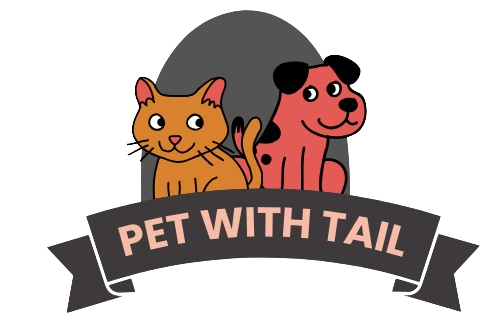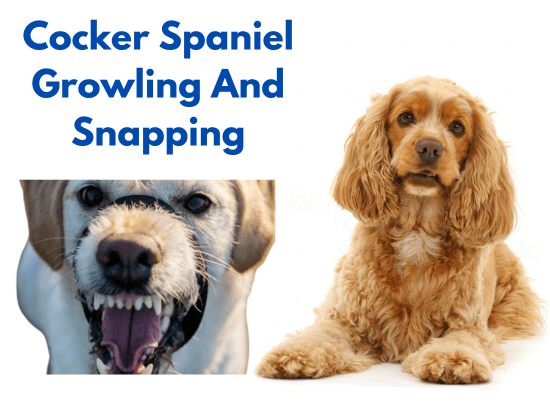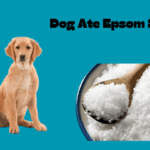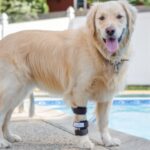Why does your cocker spaniel sometimes growl and snap at you or other people? Cocker spaniel growling and snapping Does this behavior make you worried, frustrated, or scared? If so, you are not alone. Many cocker spaniel owners face this challenge and want to understand the reasons behind it.
Cocker spaniels are a popular and lovable breed of dogs that originated in England as hunting companions. They are known for their long, silky coats, floppy ears, and expressive eyes. They are also friendly, affectionate, and playful, making them ideal family pets. However, cocker spaniels can also have a stubborn and sensitive side, which can lead to aggression in some cases.
In this article, we will explore the possible causes of cocker spaniel aggression, such as resource guarding, fear, pain, or cocker rage syndrome. We will also provide some tips on how to prevent or manage cocker spaniel biting and growling behavior, using positive and humane methods. By the end of this article, you will have a better understanding of your cocker spaniel’s behavior and how to deal with it effectively.
Contents
Why is my cocker spaniel growling and snapping?
Cocker spaniel aggression can have different causes, depending on the individual dog and the context. Some of the most common causes are:
- Resource guarding: This is when a dog becomes possessive of something that they value, such as food, toys, bones, or their favorite spot. They may growl, snap, or bite if someone tries to take away or approach their resource.
- Fear: This is when a dog feels threatened or scared by something or someone, such as a loud noise, a stranger, a bigger dog, or a new situation. They may growl, snap, or bite as a way of warning or defending themselves.
- Pain: This is when a dog is suffering from a physical discomfort or injury, such as an ear infection, a dental problem, or arthritis. They may growl, snap, or bite if someone touches them in a painful area or tries to move them.
- Cocker rage syndrome: This is a rare and controversial condition that affects some cocker spaniels and other breeds. It is characterized by sudden and unprovoked attacks of aggression, often accompanied by a glazed or blank expression. The exact cause of this syndrome is unknown, but it may be related to genetics, hormones, or brain abnormalities.
Aggressive behavior in cocker spaniels
Some examples of situations that can trigger aggressive behavior in cocker spaniels are:
- Being approached while eating or chewing a bone
- Having their ears pulled, brushed, or cleaned
- Being startled by a sudden movement or sound
- Being hugged, kissed, or lifted by a child or an adult
- Being corrected, scolded, or punished by the owner
- Being restrained, groomed, or examined by the vet
- Meeting a new person, animal, or object
- Encountering a perceived threat or challenge
These situations may not always result in aggression, but they can increase the likelihood of it, especially if the dog has not been properly socialized, trained, or desensitized to them. Therefore, it is important to understand the causes and signs of cocker spaniel aggression, and how to prevent or manage it effectively.
More Dogs Breeds Are:
When Do Rough Collies Stop Growing?
How to Prevent or Manage Cocker Spaniel Aggression
Cocker spaniels are generally friendly, affectionate, and eager to please dogs, but they can also exhibit aggression in some cases. Aggression in cocker spaniels can be caused by various factors, such as fear, territorial issues, resource guarding, dominance, or medical problems.
Aggression can be directed at people, other animals, or objects, and it can range from mild to severe. Aggression can also be mistaken for a rare condition called cocker rage, which is a form of mental lapse aggression that occurs without warning or provocation.
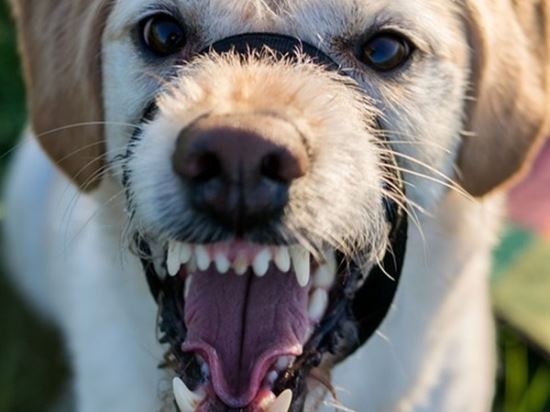
Fortunately, there are ways to prevent or manage cocker spaniel aggression, depending on the cause and severity of the problem. Here are some tips to help you deal with your cocker spaniel’s aggression:
- Emphasize the importance of early and proper socialization, training, and mental stimulation for cocker spaniels. Socializing your cocker spaniel from a young age can help him learn to be comfortable and confident around different people, animals, and situations. Training your cocker spaniel can teach him basic commands, manners, and boundaries, as well as strengthen your bond and communication. Mental stimulation can keep your cocker spaniel happy, engaged, and less likely to develop boredom-related aggression. You can provide mental stimulation by giving your cocker spaniel toys, puzzles, games, and interactive activities.
- Suggest positive and humane methods to teach cocker spaniels impulse control, bite inhibition, and appropriate behavior. Impulse control can help your cocker spaniel learn to resist his natural urges and impulses, such as chasing, barking, or biting. Bite inhibition can help your cocker spaniel learn to control the force and frequency of his bites, especially during play. Appropriate behavior can help your cocker spaniel learn what is acceptable and unacceptable in different situations. You can teach these skills by using positive reinforcement, such as praise, treats, toys, or attention, and by avoiding negative punishment, such as yelling, hitting, or isolating your cocker spaniel.
- Recommend consulting a professional behaviorist, trainer, or veterinarian if the aggression is severe, persistent, or has a medical cause. If your cocker spaniel’s aggression is not improving with your efforts, or if it is endangering yourself, others, or your cocker spaniel, you may need to seek professional help. A professional behaviorist or trainer can assess your cocker spaniel’s aggression, identify the triggers and motivations, and design a customized behavior modification plan. A veterinarian can rule out any medical issues that may be causing or contributing to your cocker spaniel’s aggression, such as pain, illness, injury, or hormonal imbalance. A veterinarian can also prescribe medication or supplements that may help reduce your cocker spaniel’s aggression.
- Warn against using harsh, punitive, or aversive techniques that can worsen the aggression or damage the bond between the owner and the dog. Using methods such as alpha rolls, choke chains, shock collars, or physical force can backfire and make your cocker spaniel more fearful, anxious, or aggressive. These methods can also erode your cocker spaniel’s trust and respect for you, and damage your relationship. Instead of using these methods, you should use positive and humane methods that can help your cocker spaniel feel safe, secure, and loved.
Cocker spaniel aggression can be a challenging and stressful problem, but it can be prevented or managed with the right approach and support. By following these tips, you can help your cocker spaniel become a happier, healthier, and more well-behaved companion. 🐶
Do cocker spaniels have anger issues?
Cocker spaniels are generally not aggressive dogs, but they can have anger issues in some cases. Anger issues in cocker spaniels can be caused by various factors, such as fear, boredom, lack of socialization, medical problems, or a rare condition called cocker rage syndrome.
Cocker rage syndrome is a form of mental lapse aggression that occurs without warning or provocation. It can be directed at people or animals and is usually unprovoked and unpredictable. It is more common in solid-colored and darker-colored cocker spaniels, especially males. Cocker rage syndrome is very rare, affecting less than 10% of all cockers.
If your cocker spaniel has anger issues, you should consult a professional behaviorist, trainer, or veterinarian to determine the cause and the best treatment. You should also avoid using harsh, punitive, or aversive techniques that can worsen the anger or damage the bond between you and your dog. Instead, you should use positive and humane methods that can help your cocker spaniel feel safe, secure, and loved. 🐶
How to Stop Cocker Rage
Cocker rage is a rare and unpredictable form of aggression that affects some cocker spaniels. It can cause them to attack people or animals without warning or provocation, and then act as if nothing happened. Cocker rage is also known as sudden onset aggression or mental lapse aggression.
There is no clear cause or cure for cocker rage, but some possible factors include genetics, epilepsy, seizures, or hormonal imbalance. Cocker rage is more common in solid-colored and darker-colored cockers, especially males.
If your cocker spaniel has cocker rage, here are some tips to help you stop or manage it:
- Consult a professional behaviorist, trainer, or veterinarian. They can diagnose your cocker spaniel’s condition, rule out any medical issues, and prescribe medication or supplements if needed. They can also design a customized behavior modification plan to help your cocker spaniel cope with stress, fear, or anxiety, and reduce the frequency and intensity of the attacks.
- Avoid triggering situations. Try to identify the patterns or circumstances that precede an attack, such as sleeping, eating, playing, or being startled. Avoid exposing your cocker spaniel to these situations, or prepare him for them by using calming signals, cues, or rewards. If an attack occurs, stay calm and remove yourself and others from the scene as quickly and safely as possible.
- Use positive and humane methods. Do not use harsh, punitive, or aversive techniques that can worsen the cocker rage or damage the bond between you and your dog. Instead, use positive reinforcement, such as praise, treats, toys, or attention, to reward your cocker spaniel for good behavior. Teach him impulse control, bite inhibition, and appropriate behavior using gentle and consistent methods.
- Socialize and train your cocker spaniel from an early age. This can help your cocker spaniel learn to be comfortable and confident around different people, animals, and situations. It can also prevent or reduce other types of aggression, such as fear, territorial, resource guarding, or dominance. Provide your cocker spaniel with mental stimulation, exercise, and enrichment to keep him happy, engaged, and less likely to develop boredom-related aggression.
Cocker rage can be a challenging and stressful problem, but it can be stopped or managed with the right approach and support. By following these tips, you can help your cocker spaniel become a happier, healthier, and more well-behaved companion. 🐶
Why is My Cocker Spaniel Biting Me?
Biting is a natural behavior for cocker spaniels, especially when they are puppies. They use their mouths to explore their environment, play with others, and communicate their needs. However, biting can also be a sign of aggression, fear, anxiety, pain, or discomfort in some cases. If your cocker spaniel is biting you or others, you need to find out the cause and the best way to stop it.
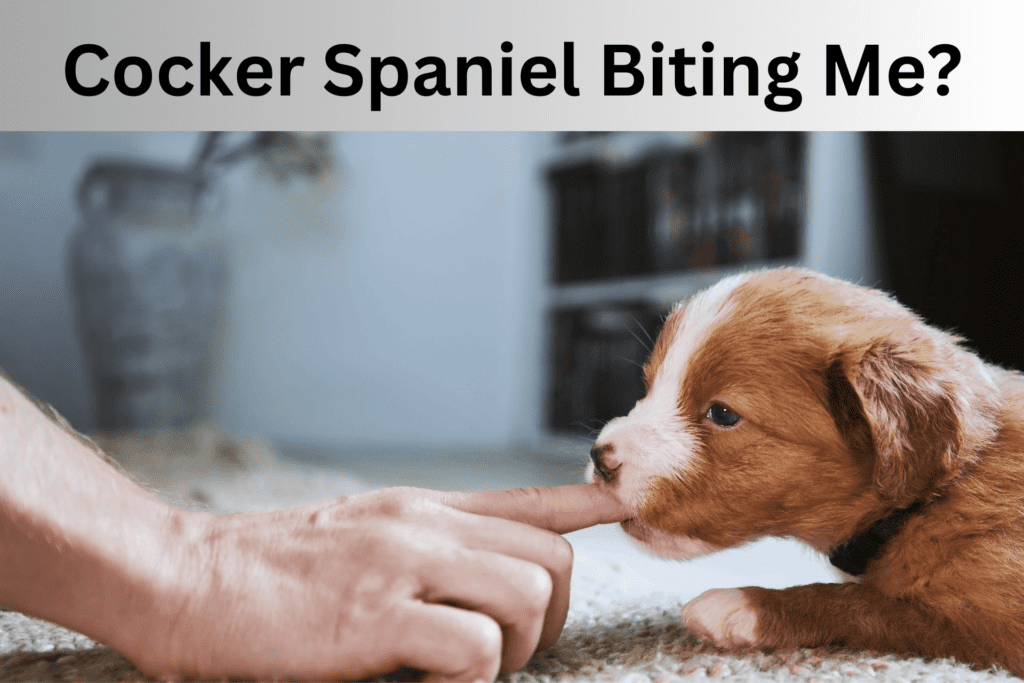
Possible Causes of Biting
There are many possible reasons why your cocker spaniel is biting you, such as
- Fear and anxiety. Your cocker spaniel may bite when he feels scared or nervous in certain situations, such as meeting new people, animals, or noises, or dealing with changes in his routine. He may bite to defend himself or to escape from the perceived threat.
- Pain or discomfort. Your cocker spaniel may bite when he is suffering from a medical condition, such as an injury, illness, or hormonal imbalance. He may bite to express his pain or to avoid being touched or handled.
- Possessiveness. Your cocker spaniel may bite when he is guarding his food, toys, bed, or territory against other dogs or people. He may bite to warn them to stay away or to assert his dominance.
- Prey drive. Your cocker spaniel may bite when he is chasing or hunting small animals, such as rabbits, squirrels, or birds. He may bite to catch or kill his prey, or to play with it.
- Socialization and play. Your cocker spaniel may bite when he is interacting with other dogs or people, especially during play. He may bite to communicate, to test his limits, or to have fun. He may not know how to control the force or frequency of his bites, or when to stop.
- Temperament. Your cocker spaniel may bite because of his personality, mood, or energy level. He may bite when he is bored, excited, frustrated, or stressed. He may bite to get attention, to release tension, or to cope with his emotions.
- Genetic predisposition. Your cocker spaniel may bite because of a rare condition called cocker rage syndrome, which is a form of mental lapse aggression that occurs without warning or provocation. It is more common in solid-colored and darker-colored cockers, especially males. It is very rare, affecting less than 10% of all cockers.
Suggested: Brown Nose Puppy
How to Stop Biting
The best way to stop your cocker spaniel from biting depends on the cause and severity of the problem. However, some general tips are:
- Consult a professional behaviorist, trainer, or veterinarian. They can help you diagnose the cause of your cocker spaniel’s biting, rule out any medical issues, and prescribe medication or supplements if needed. They can also design a customized behavior modification plan to help your cocker spaniel learn to behave appropriately.
- Avoid triggering situations. Try to identify the patterns or circumstances that precede a bite, such as sleeping, eating, playing, or being startled. Avoid exposing your cocker spaniel to these situations, or prepare him for them by using calming signals, cues, or rewards. If a bite occurs, stay calm and remove yourself and others from the scene as quickly and safely as possible.
- Use positive and humane methods. Do not use harsh, punitive, or aversive techniques that can worsen the biting or damage the bond between you and your dog. Instead, use positive reinforcement, such as praise, treats, toys, or attention, to reward your cocker spaniel for good behavior. Teach him impulse control, bite inhibition, and appropriate behavior using gentle and consistent methods.
- Socialize and train your cocker spaniel from an early age. This can help your cocker spaniel learn to be comfortable and confident around different people, animals, and situations. It can also prevent or reduce other types of biting, such as fear, territorial, resource guarding, or dominance. Provide your cocker spaniel with mental stimulation, exercise, and enrichment to keep him happy, engaged, and less likely to bite.
Biting can be a challenging and stressful problem, but it can be stopped or managed with the right approach and support. By following these tips, you can help your cocker spaniel become a happier, healthier, and more well-behaved companion. 🐶
The Cocker Spaniel Breed
The cocker spaniel is a type of spaniel dog that belongs to two breeds: the American Cocker Spaniel and the English Cocker Spaniel. Both breeds are commonly called simply cocker spaniels in their countries of origin. They are popular as family pets and show dogs, and they have a sweet and gentle temperament. They are also proficient hunters and sporting dogs, especially woodcocks.
History and Origin
The cocker spaniel originated from Spain, where it was used as a hunting dog for centuries. The name “cocker” comes from their ability to hunt the Eurasian woodcock, a type of game bird. The cocker spaniel was brought to England by the Romans, where it was further developed and refined. In the 19th century, the cocker spaniel was classified as a type of field spaniel, along with other spaniel breeds such as the Sussex Spaniel and the Clumber Spaniel.
In the early 20th century, the cocker spaniel was divided into two breeds: the American Cocker Spaniel and the English Cocker Spaniel. The American Cocker Spaniel was bred to a different standard, with a smaller size, a shorter muzzle, and a more domed head. The American Cocker Spaniel also specialized in hunting the American woodcock, a different species from the Eurasian woodcock. The English Cocker Spaniel retained the original characteristics of the cocker spaniel, with a larger size, a longer muzzle, and a flatter head. The English Cocker Spaniel also had a wider range of hunting abilities, including flushing, retrieving, and tracking.
The two breeds were recognized as separate by the American Kennel Club in 1946 and by The Kennel Club in 1970. There is also a working strain of the English Cocker Spaniel, which is bred for hunting performance rather than appearance. The working strain is not recognized as a separate breed but as a variation of the English Cocker Spaniel.
Appearance and Characteristics
The cocker spaniel is a small to medium-sized dog, with a sturdy and balanced body. The American Cocker Spaniel is the smallest of the sporting dogs, standing about 14 to 15 inches at the shoulder and weighing about 20 to 30 pounds. The English Cocker Spaniel is slightly larger, standing about 15 to 17 inches at the shoulder and weighing about 25 to 35 pounds. The working strain of the English Cocker Spaniel is usually smaller and lighter than the show strain.
The cocker spaniel has a long and silky coat, with feathering on the ears, chest, legs, and tail. The coat comes in a variety of colors and patterns, including black, tan, red, buff, silver, cream, sable, roan, merle, and parti-color. The coat requires regular grooming to prevent mats and tangles, and some owners prefer to trim the coat for easier maintenance. The cocker spaniel also has long and low-set ears, which are prone to infections and need to be cleaned frequently.
The cocker spaniel has large and expressive eyes, which can be dark or light depending on the coat color. The eyes exude intelligence and affection, and are often described as “dreamy” or “melting”. The cocker spaniel also has a broad and deep muzzle, with a scissors bite and strong jaws. The nose can be black or brown, depending on the coat color. The cocker spaniel has a moderate and graceful neck, a level and strong back, a well-developed chest, and a docked or natural tail. The tail is usually carried horizontally or slightly higher and is wagged enthusiastically.
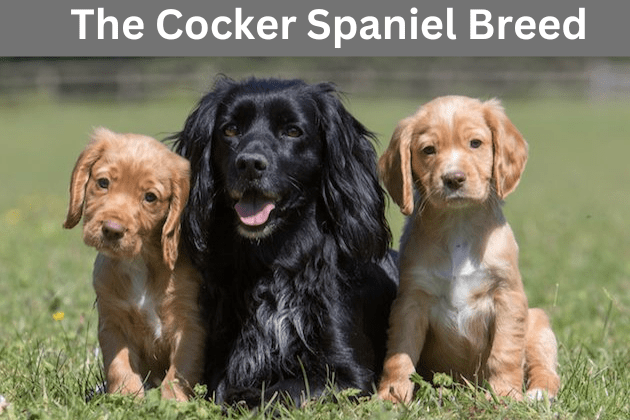
Temperament and Personality
The cocker spaniel is a friendly, happy, and gentle dog, with a lively and playful personality. They are eager to please and easy to train, and they excel in various dog sports and activities, such as agility, obedience, rally, tracking, and flyball. They are also good therapy and service dogs, as they are sensitive to human emotions. They are loyal and devoted to their owners, and they enjoy being part of the family.
The cocker spaniel is also a sociable and outgoing dog, who gets along well with other dogs, animals, and people. They are especially good with children, as they are patient and tolerant of their behavior. However, they may not be suitable for very young or rough children, as they can be easily hurt or startled by them. They also need proper socialization and training from an early age, to prevent them from becoming shy, timid, or aggressive. They may also suffer from separation anxiety if left alone for too long.
The cocker spaniel is a moderately active and energetic dog, who needs regular exercise and mental stimulation to keep them healthy and happy. They enjoy going for walks, playing fetch, or swimming, as well as having toys, puzzles, and games to challenge their minds. They also have a strong hunting instinct and may chase or bark at small animals, birds, or objects. They need a fenced yard or a leash to prevent them from wandering off or getting into trouble. They also need a lot of attention and affection from their owners, and they do not like to be ignored or neglected.
Health and Care
The cocker spaniel is a generally healthy and long-lived dog, with a life expectancy of about 12 to 15 years. However, they are prone to some health issues, such as:
- Eye problems, such as cataracts, glaucoma, progressive retinal atrophy, cherry eye, or dry eye
- Ear problems, such as infections, mites, or hematomas
- Skin problems, such as allergies, dermatitis, or seborrhea
- Orthopedic problems, such as hip dysplasia, luxating patella, or arthritis
- Cardiac problems, such as mitral valve disease, dilated cardiomyopathy, or heart murmurs
- Neurological problems, such as epilepsy, syringomyelia, or cerebellar ataxia
- Endocrine problems, such as hypothyroidism, diabetes, or Cushing’s disease
- Urinary problems, such as stones, infections, or incontinence
- Immune problems, such as autoimmune hemolytic anemia, immune-mediated thrombocytopenia, or lupus
- Cancer, such as lymphoma, melanoma, or mast cell tumors
- A rare condition called cocker rage syndrome is a form of mental lapse aggression that occurs without warning or provocation.
To prevent or reduce these health issues, the cocker spaniel needs regular veterinary check-ups, vaccinations, parasite control, and screening tests. They also need a high-quality and balanced diet, fresh water, and proper dental care. They may also need supplements, medication, or surgery, depending on their condition. They also need to be spayed or neutered, to prevent unwanted pregnancies, behavioral problems, or reproductive diseases.
Conclusion
Cocker spaniel growling and snapping can have different causes, such as resource guarding, fear, pain, or cocker rage syndrome. It can also be triggered by various situations, such as being approached while eating, having their ears pulled, or being startled. However, cocker spaniel aggression can be prevented or managed effectively, using positive and humane methods, such as socialization, training, and mental stimulation.
Cocker spaniels are wonderful dogs that can bring joy and companionship to their owners. However, they also need understanding, patience, and guidance from their owners to behave appropriately. If you have a cocker spaniel that growls and snaps, do not lose hope or give up on them. Instead, try to find out the reason behind their behavior and seek professional help if needed.
Do you have a cocker spaniel that growls and snaps? How do you deal with it? Share your experience and tips with us in the comments section below. We would love to hear from you.
FAQs about Cocker spaniel growling and snapping
Q: Why is my cocker spaniel growling and snapping?
- A: Your cocker spaniel may be growling and snapping due to various reasons, such as resource guarding, fear, pain, or cocker rage syndrome. These are behaviors that indicate your dog is feeling threatened, scared, or uncomfortable, and wants you or others to back off.
Q: How can I prevent or manage my cocker spaniel’s aggression?
- A: You can prevent or manage your cocker spaniel’s aggression by providing proper socialization, training, and mental stimulation for your dog. You can also use positive and humane methods to teach your dog impulse control, bite inhibition, and appropriate behavior. If your dog’s aggression is severe, persistent, or has a medical cause, you should consult a professional behaviorist, trainer, or veterinarian.
Q: What is cocker rage syndrome and how can I recognize it?
- A: Cocker rage syndrome is a rare and controversial condition that affects some cocker spaniels and other breeds. It is characterized by sudden and unprovoked attacks of aggression, often accompanied by a glazed or blank expression. The exact cause of this syndrome is unknown, but it may be related to genetics, hormones, or brain abnormalities. If your cocker spaniel exhibits this behavior, you should seek medical attention as soon as possible.
Q: How should I react when my cocker spaniel growls or snaps at me or others?
- A: You should not punish, scold, or hit your cocker spaniel when it growls or snaps, as this can worsen the aggression or damage the bond between you and your dog. Instead, you should remain calm, avoid eye contact, and slowly move away from the situation. You should also try to identify the trigger of the aggression and avoid or modify it in the future.
Q: How can I help my cocker spaniel feel more comfortable and confident?
- A: You can help your cocker spaniel feel more comfortable and confident by providing a safe and secure environment, a consistent routine, and positive reinforcement. You can also expose your dog to different people, animals, and situations gradually and carefully, and reward your dog for calm and friendly behavior. You should also avoid forcing your dog into situations that make it nervous or fearful, and respect your dog’s boundaries and signals.
